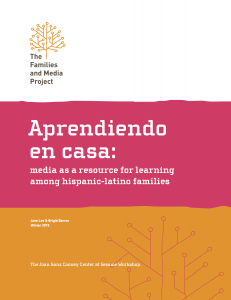“Yeah, when [my daughter] doesn’t know something, I go to YouTube. I see the video. And once I understand how it is, then I’ll teach her. I explain it to her.”
 Elena, mother to 9-year-old Alicia, describes how she learns important information from the Internet to help Alicia learn about fractions. Alicia is of Ecuadorian descent and lives in a media-rich home with TVs, cable access, DVD players, multiple smartphones, a tablet, high-speed Internet access, and computers. The family’s experience is highlighted in our new report, Aprendiendo en Casa: Media as a Resource for Learning among Hispanic-Latino Families.
Elena, mother to 9-year-old Alicia, describes how she learns important information from the Internet to help Alicia learn about fractions. Alicia is of Ecuadorian descent and lives in a media-rich home with TVs, cable access, DVD players, multiple smartphones, a tablet, high-speed Internet access, and computers. The family’s experience is highlighted in our new report, Aprendiendo en Casa: Media as a Resource for Learning among Hispanic-Latino Families.
Hispanic-Latinos are the largest minority group in the United States. However, the term “Hispanic-Latino” itself encapsulates groups of individuals with diverse backgrounds and experiences. Research focusing on Hispanic-Latino and other minority groups often adopt a deficit perspective, juxtaposing them against mainstream, dominant, White culture rather than examining knowledge and practices in these families as being important in their own right. This study was borne out of such a need, as well as the desire to better understand the role that media plays for learning among Hispanic-Latino families while taking unique circumstances, such as language (families that speak only Spanish vs. those that are bilingual, and those that speak only English), into account. Based on an oversample of Hispanic-Latino families in a national survey, it examines the dimensions of access; children’s use of educational content on different media platforms and parents’ perceptions of that learning; the use of media for learning (among both parents and children); and joint media engagement between parents and children. Therefore, in addition to children’s media environment and media use, this study also considers parent-child interactions that have important implications for engagement and learning.
Not surprisingly, we found that Hispanic-Latino families have different levels of access to media. While some platforms—such as television, cable, and computers—were prevalent, other devices such as tablets, smartphones, and e-readers were less so. Limits in access impinge on both parent and children’s use of media for learning. Parents who had less access to digital tools (high speed Internet connection, tablet, or smartphone) were less likely to use the Internet for their own learning. Parents’ use of the web for learning is also related to their child’s use of educational content, underscoring the important associations among access, parents’ use, and children’s use of educational media.
Parents largely feel that their child has learned from educational media, but the degree of perceived learning varies by subject and platform. Among the range of media platforms, television is where children most commonly access educational content. Parents were most likely to feel that their child has learned reading and English from educational media. In addition to acknowledging the importance of educational content, the survey also centers on the dynamics that happen during and after the media encounter—joint media engagement, and the important conversations and activities that educational media can engender. This study found that educational content is often fodder for dialog, imaginative play, and asking questions regardless of the language spoken at home. Spanish-only and bilingual families were also especially likely to report that their child taught them something they didn’t know after engaging with educational media.
We conclude the report with a set of implications for media designers, practitioners, and researchers in the hopes that this research will translate into concrete, actionable knowledge for parents and those who touch Hispanic-Latino families’ lives, whether they are educators and practitioners, or designers who create engaging content for young users. These include the importance of providing non-digital and Spanish-language resources; adopting an intergenerational approach to media design that considers children, parents, and perhaps grandparents in the media experience; and creating media that catalyzes conversations and interactions between children and parents. We also propose suggestions for a research agenda that builds on these findings. At a time when media offerings are expanding at a breathtaking pace, vying for children’s time and attention, it is especially important to bear in mind the unique needs of different audiences, including those of Hispanic-Latino families.
One of my favorite aspects of this report is that it draws upon qualitative work (from which the opening quote comes) conducted by colleagues from the Families and Media (FAM) Project. Based on ethnographic data from the northeast U.S. and California, the case studies illustrate important practices and interactions described in the survey results. The report is enriched by these vignettes, which bring practices such as Elena and Alicia’s to life. Such a blend of quantitative and qualitative approaches is still relatively uncommon in this field, particularly as it relates to populations in the non-majority culture. Colleagues from the Aprendiendo Juntos Council (AJC) also provided invaluable input on the report. Both the FAM Project and the AJC embody the close collaboration across disciplines and methodologies; this has proven incredibly fruitful in building knowledge in this field. It has also yielded rich opportunities (not to mention a great deal of fun!) to learn from one another, bound by our common interest in understanding and creating meaningful, rich media experiences for children and families.


